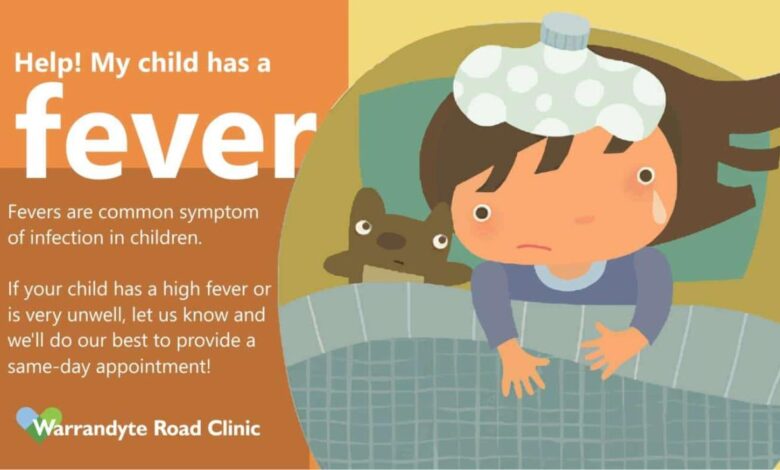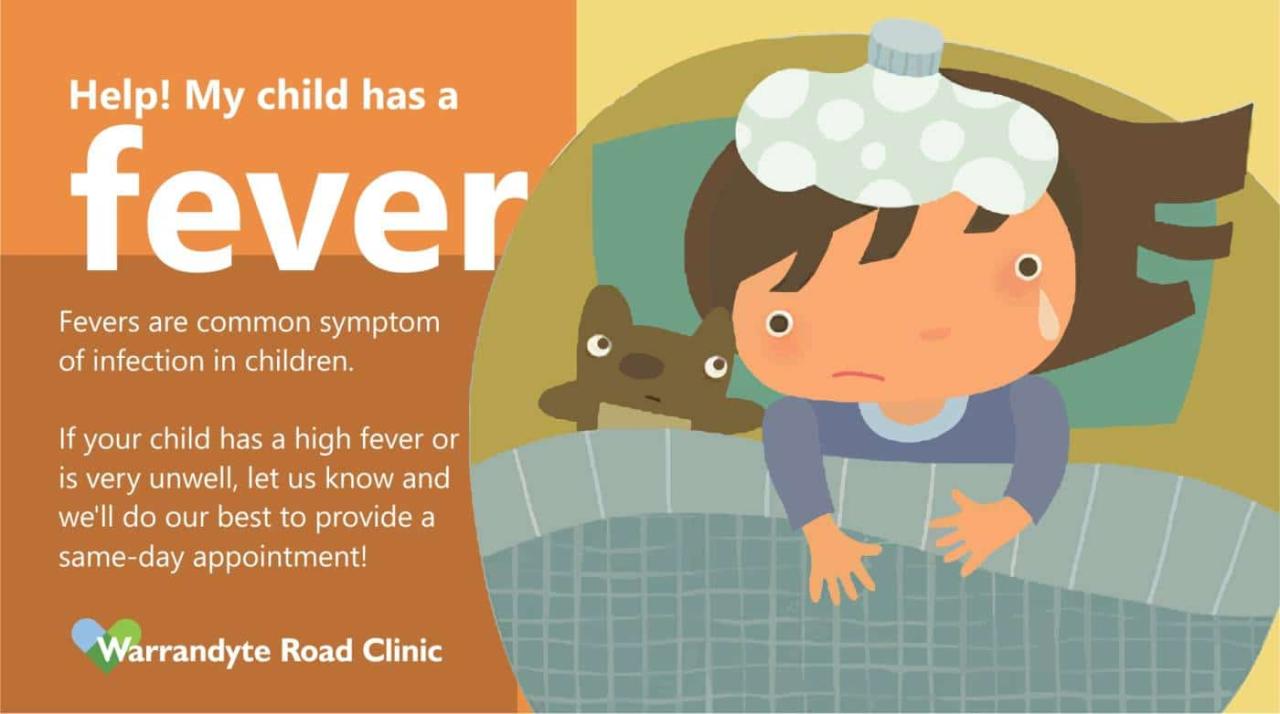
What to know about fever in children? Understanding fevers in kids is crucial for parents and caregivers. This guide dives deep into the causes, symptoms, and when to seek medical attention. From recognizing the subtle signs to exploring home remedies and preventative measures, we’ll equip you with the knowledge to navigate this common childhood concern effectively and confidently.
This comprehensive guide covers everything from the basics of fever definition and measurement to the more complex issues of potential underlying conditions and complications. We’ll provide practical advice, backed by evidence, to help you make informed decisions about your child’s health.
Understanding Fever in Children
A fever in a child is a rise in body temperature above the normal range. It’s a common sign that the body is fighting an infection or other illness. Recognizing the signs and understanding the causes can help parents and caregivers respond appropriately and effectively.A child’s normal body temperature can vary slightly, but generally, a temperature of 99.5°F (37.5°C) or higher is considered a fever.
Fluctuations in temperature can be affected by factors like activity level, time of day, and environment. The critical aspect is recognizing a sustained elevation in temperature beyond the normal range.
Body’s Response to Fever
The body’s response to fever is a complex process designed to combat infection. The hypothalamus, the body’s thermostat, raises the set point in response to the presence of pyrogens (substances produced by bacteria or viruses). This increase in temperature can inhibit the growth of pathogens and enhance the activity of immune cells, helping the body fight off the infection.
Common Causes of Fever in Children
Fever in children can stem from a multitude of factors. Viral infections, such as the common cold or influenza, are frequent culprits. Bacterial infections, including ear infections, strep throat, and pneumonia, can also lead to fevers. Other potential causes include teething, vaccinations, and reactions to medications. Sometimes, fevers can be caused by underlying medical conditions, requiring prompt medical attention.
Categorization of Fevers in Children
| Symptom | Cause | Severity Level |
|---|---|---|
| High fever (104°F or higher) | Severe bacterial infections (e.g., meningitis, pneumonia), severe viral infections, or certain medications. | Urgent medical attention required. |
| Moderate fever (101°F to 103°F) | Common viral infections (e.g., common cold, influenza), ear infections, strep throat, teething, vaccinations, and other less severe bacterial infections. | Monitor closely for worsening symptoms. Consult a pediatrician if symptoms persist or worsen. |
| Low-grade fever (100°F to 100.9°F) | Mild viral infections, teething, stress, and some other minor conditions. | Monitor for other symptoms. Usually, no immediate medical intervention is necessary unless accompanied by other concerning symptoms. |
Recognizing the Symptoms
Understanding fever in children goes beyond just a high temperature reading. A comprehensive approach involves recognizing a range of associated symptoms that can offer valuable clues about the underlying cause and the severity of the illness. This often requires a keen observation of your child’s behavior and physical state.Recognizing the accompanying symptoms is crucial for determining the appropriate response and seeking timely medical attention if needed.
Careful monitoring can help distinguish between a mild, self-limiting illness and a more serious condition.
Identifying Accompanying Symptoms
Observing symptoms beyond just elevated temperature is essential for a more complete understanding of the situation. The presence of a rash, lethargy, or difficulty breathing, for instance, can significantly influence the course of action.
- Rash: A rash, especially one that is spreading or accompanied by other symptoms, warrants attention. Its appearance, location, and texture can provide important diagnostic clues. For example, a measles rash typically starts on the face and spreads downward, while a scarlet fever rash is often fine and sandpaper-like.
- Lethargy: Unusual tiredness or lack of energy (lethargy) can be a sign of a more significant illness. It is important to note that a child’s baseline energy levels can vary, so any significant change from their typical behavior should be considered. A child who is normally active and playful might become withdrawn or unresponsive. This should not be ignored, as it can indicate dehydration or more serious conditions.
- Difficulty Breathing: Shortness of breath, rapid breathing, or wheezing can signal a respiratory infection or other underlying issues. Monitoring the child’s breathing patterns is important, noting any changes in rate or effort. If breathing becomes labored or noisy, immediate medical attention is recommended.
Taking a Child’s Temperature Accurately
Accurate temperature measurement is crucial for assessing a child’s condition. Different methods and thermometers offer varying degrees of accuracy and convenience.
- Choosing the Right Thermometer: Several types of thermometers are available for taking a child’s temperature, each with its own advantages and limitations. Oral thermometers are typically used for older children who can hold the thermometer in their mouth. Rectal thermometers are more accurate for infants and young children, but are less comfortable.
| Method | Type of Thermometer | Accuracy | Ease of Use | Suitable for |
|---|---|---|---|---|
| Oral | Digital Oral Thermometer | Good | Relatively Easy | Children over 4 years old who can cooperate |
| Rectal | Digital Rectal Thermometer | Most Accurate | Slightly More Difficult | Infants and young children |
| Temporal Artery (Forehead) | Temporal Artery Thermometer | Good | Quick and Convenient | All ages |
| Tympanic (Ear) | Digital Tympanic Thermometer | Good | Quick and Relatively Easy | Infants and older children |
Accurate temperature measurement is crucial for determining the appropriate course of action.
When to Seek Medical Attention
Knowing when a child’s fever warrants a trip to the doctor is crucial. A fever itself isn’t always cause for alarm, but certain symptoms and patterns indicate a need for immediate medical attention. This section details those situations, helping parents make informed decisions during a child’s illness.While a fever is often a sign of a minor infection, it can also signal more serious underlying conditions.
Careful monitoring and a clear understanding of when to seek professional help are essential for ensuring your child’s well-being.
Signs of Urgent Medical Attention
Fever, in and of itself, doesn’t always necessitate immediate medical intervention. However, certain accompanying symptoms or patterns suggest a more serious illness that requires prompt evaluation. These include severe symptoms or a prolonged duration of fever, coupled with other concerning signs.
Knowing the signs of a fever in kids is crucial, but sometimes sleep is just as important! Choosing the right mattress can impact nighttime comfort, and the debate between the Purple Hybrid and Saatva mattresses is a hot one, influencing sleep quality for the whole family. Ultimately, researching purple hybrid vs saatva mattress comparisons will help you make the best choice for your little one’s sleep environment.
However, if your child has a fever, always prioritize seeking medical advice from a trusted pediatrician.
- Significant changes in behavior, such as lethargy, irritability, or difficulty waking up, can be a critical indicator. This includes noticeable disorientation, confusion, or loss of consciousness.
- High fevers (above 104°F or 40°C) or fevers that persist for more than three days, especially if not responding to over-the-counter medications, should be evaluated. Parents should note that fevers can vary based on a child’s age, developmental stage, and overall health.
- Stiffness in the neck, difficulty moving the neck, or other signs of meningitis (inflammation of the membranes surrounding the brain and spinal cord) are serious and require immediate medical attention. Seek medical attention immediately if you observe these symptoms.
- A rash that accompanies the fever, particularly if it is accompanied by other symptoms such as difficulty breathing or swallowing, or if the rash is spreading rapidly, needs prompt evaluation. Rashes can vary in appearance, so it’s important to be aware of changes in the skin’s condition.
- Seizures, particularly if they are prolonged or recurring, are a medical emergency and require immediate intervention. These can be accompanied by unusual behaviors or loss of consciousness.
Factors to Consider When Deciding to Seek Medical Attention
Deciding whether to take your child to the doctor for a fever involves careful consideration of several factors. The following table summarizes these factors, categorized by symptom, duration, and severity.
| Symptom | Duration | Severity |
|---|---|---|
| Lethargy, irritability, difficulty waking up, or unusual behavior | Any duration | High |
| High fever (above 104°F/40°C) | More than 3 days without improvement | High |
| Rash with fever, difficulty breathing or swallowing, rapid spread of rash | Any duration | High |
| Stiff neck, difficulty moving neck | Any duration | High |
| Seizures, prolonged or recurring | Any duration | Extreme |
| Fever with persistent vomiting or diarrhea | More than 24 hours | Moderate to High |
| Fever with ear pain, sore throat, or difficulty swallowing | More than 2 days | Moderate |
| Fever in infants (under 3 months) | Any duration | High |
Important Note: This table is for guidance only. Always consult with a healthcare professional for personalized advice regarding your child’s specific situation.
Home Remedies and Management
Managing a child’s fever safely and effectively involves a combination of careful monitoring, supportive care, and, when necessary, medical intervention. Understanding the different approaches to fever reduction, including both home remedies and potential medications, is crucial for parents and caregivers. It’s essential to remember that these remedies are supportive and should not replace professional medical advice.
Common Home Remedies for Fever Management
Many parents turn to home remedies to help manage a child’s fever. These remedies often aim to reduce the child’s body temperature and provide comfort. However, the effectiveness of these methods varies, and it’s crucial to use them in conjunction with other measures, such as ensuring the child is well-hydrated and resting.
Knowing what’s normal for a child’s fever is crucial, but beyond that, understanding the importance of preparedness is equally vital, especially in today’s world. For instance, navigating the complexities of healthcare decisions can sometimes necessitate having alternative plans in place, like plan b what to know about stocking up after overturn of roe v wade , which is equally important to consider.
Ultimately, staying informed and prepared, whether for a child’s fever or broader life circumstances, is key to maintaining peace of mind.
- Cool Compresses: Applying cool, damp cloths or a cool bath can help lower a child’s body temperature. This method works by drawing heat away from the body. While generally safe, the effectiveness is moderate and temporary. Overcooling should be avoided. Ensure the child is not shivering or feeling uncomfortable from the cool temperature.
The bath water temperature should be lukewarm and not too cold.
- Plenty of Fluids: Keeping a child hydrated is essential during a fever. Fluids help the body eliminate excess heat and maintain proper function. Water, clear broths, and electrolyte drinks are excellent choices. Avoid sugary drinks, as they can worsen dehydration.
- Rest and Comfort: Rest is vital for the body to fight infection and recover from a fever. A quiet, comfortable environment will promote rest and reduce stress. Dress the child in loose, breathable clothing to promote comfort and avoid overheating.
Effectiveness and Limitations of Home Remedies
The effectiveness of home remedies for fever reduction varies. While cool compresses and fluids can provide temporary relief and comfort, they may not significantly lower a child’s core body temperature. Rest and comfort are essential but don’t directly address the fever itself. Important to note, these methods are best used in conjunction with other measures and not as a primary method of fever reduction.
Safe and Effective Ways to Reduce Fever at Home
Effective fever reduction involves a combination of approaches. Maintaining a comfortable environment, ensuring adequate hydration, and monitoring the child’s condition closely are key. Never try to force a fever reduction, and always consult a doctor if you have concerns. It is important to consider the child’s age, weight, and overall health when deciding on a course of action.
- Monitoring for Complications: Pay close attention to the child’s behavior and symptoms. Look for signs of dehydration, difficulty breathing, lethargy, or changes in the child’s usual demeanor. If the child is exhibiting concerning signs, seek immediate medical attention.
- Use of Fever-Reducing Medications: Acetaminophen and ibuprofen are commonly used to reduce fever. Always follow the dosage instructions carefully, considering the child’s weight and age. These medications can effectively lower body temperature, but their effectiveness is not guaranteed for every child. Consult with a doctor or pharmacist for specific dosage guidelines. Do not administer both acetaminophen and ibuprofen simultaneously, unless directed by a doctor.
Proper Use of Fever-Reducing Medications
Using fever-reducing medications like acetaminophen or ibuprofen safely and effectively requires careful attention to dosage instructions. The specific dosage depends on the child’s weight and age. Always refer to the medication packaging for precise guidelines. Never exceed the recommended dosage, and always consult a healthcare professional if you have any doubts.
| Home Remedy | Mechanism | Potential Side Effects |
|---|---|---|
| Cool Compresses | Draws heat away from the body | Possible discomfort, shivering if not done properly |
| Fluids | Maintains hydration, helps eliminate excess heat | None, if given appropriately. Dehydration if not enough fluids are given. |
| Rest | Allows body to conserve energy for healing | None |
| Acetaminophen | Reduces body temperature by inhibiting prostaglandin production | Liver damage if overdose |
| Ibuprofen | Reduces body temperature by inhibiting prostaglandin production | Stomach upset, allergic reactions |
Underlying Conditions and Complications
Fever in children, while often a symptom of a common viral or bacterial infection, can sometimes signal a more serious underlying condition. Understanding these possibilities is crucial for prompt and appropriate medical intervention. Ignoring a fever, especially a persistent or high one, can lead to potentially harmful complications.While most fevers in children resolve on their own, it’s essential to recognize that some underlying conditions can cause fever as a primary or secondary symptom.
This section will explore some potential causes, the complications that can arise from untreated fevers, and the importance of seeking professional medical attention for a proper diagnosis.
Potential Underlying Conditions
Identifying the precise cause of a fever is a vital aspect of pediatric care. Several conditions can manifest with fever in children. These range from relatively benign conditions to more serious illnesses.
- Infections:
- Bacterial infections like pneumonia, meningitis, and bloodstream infections (septicemia) can cause high fevers. These infections require immediate medical attention to prevent severe complications.
- Viral infections like influenza and cytomegalovirus (CMV) can also lead to fever. While often manageable, viral infections can still necessitate monitoring and appropriate supportive care.
- Autoimmune Diseases:
- Conditions like juvenile idiopathic arthritis (JIA) are characterized by inflammation and fever. Early diagnosis and treatment are essential to prevent long-term joint damage.
- Cancer:
- Some types of childhood cancers, such as leukemia, can present with fever as a symptom. The fever may be accompanied by other symptoms, like fatigue or bruising.
- Other Medical Conditions:
- Conditions like inflammatory bowel disease (IBD) or kidney infections can cause fever. These conditions require specialized medical attention for proper diagnosis and management.
Complications of Untreated or Poorly Managed Fevers
Untreated or inadequately managed fevers in children can lead to various complications. Prompt medical intervention is crucial to mitigate these risks.
- Seizures:
- High fevers, especially in young children, can trigger febrile seizures. These are typically harmless, but it’s vital to seek medical attention to rule out other underlying causes.
- Dehydration:
- High fevers can lead to increased fluid loss through sweating, and if not adequately replaced, can result in dehydration, potentially affecting organ function.
- Brain Damage:
- Untreated infections, such as meningitis, can lead to serious brain damage or even death. Early diagnosis and treatment are crucial to prevent such severe outcomes.
- Organ Damage:
- Severe infections, particularly septicemia, can cause significant damage to vital organs, like the kidneys or liver. Prompt medical intervention is vital in these cases.
Importance of Professional Diagnosis
A healthcare professional is essential for accurate diagnosis and appropriate management of fever in children.
A medical doctor can distinguish between a common viral infection and a more serious underlying condition. They can also assess the child’s overall health, conduct necessary tests, and recommend the most suitable course of action.
Comparison of Underlying Conditions
Different underlying conditions causing fever in children exhibit varying characteristics and symptoms.
| Condition | Key Characteristics |
|---|---|
| Bacterial Infection | Often accompanied by other symptoms like localized pain, redness, or discharge. May cause more rapid onset of fever. |
| Viral Infection | Usually accompanied by other symptoms like cough, runny nose, or fatigue. Fever often resolves more gradually. |
| Autoimmune Disease | Characterized by persistent inflammation and fever. Often associated with joint pain or swelling. |
| Cancer | May present with persistent fever, fatigue, weight loss, or bruising. Often accompanied by other systemic symptoms. |
Long-Term Effects of Untreated Fevers
The long-term effects of untreated fevers in children depend heavily on the underlying cause. Some infections, if left untreated, can lead to permanent organ damage or neurological complications.
Examples include permanent hearing loss from untreated meningitis or developmental delays due to untreated infections. It’s crucial to prioritize prompt medical attention to prevent these potentially devastating outcomes.
Prevention Strategies

Fevers in children can be distressing, but proactive measures can significantly reduce their frequency and severity. Understanding the factors contributing to fevers allows for targeted preventative strategies, ensuring a healthier and happier childhood.Preventing fevers in children involves a multifaceted approach, encompassing hygiene, vaccination, and lifestyle choices. By prioritizing these elements, parents and caregivers can create an environment that minimizes the risk of infections leading to fever.
Hygiene Practices
Maintaining good hygiene is fundamental to preventing the spread of illnesses. Regular handwashing with soap and water is crucial, especially after using the restroom, before eating, and after contact with potentially contaminated surfaces. Encouraging children to practice these habits early on sets a positive example and helps establish good hygiene routines. Frequent handwashing and cleaning of common areas are essential to minimize the presence of pathogens.
This includes cleaning toys, doorknobs, and frequently touched surfaces.
Vaccinations
Vaccination plays a critical role in preventing infectious diseases that often cause fevers. Immunizations build immunity against specific pathogens, decreasing the likelihood of infection and subsequent fever. Immunization schedules are carefully designed to provide optimal protection at various stages of childhood development. By adhering to recommended vaccination schedules, parents can significantly reduce the risk of fever-inducing illnesses.
Understanding fevers in kids is crucial. It’s important to monitor their temperature, watch for other symptoms, and know when to seek medical attention. Interestingly, research into sleep patterns, like whether people who need less sleep have a special gene do people who need less sleep have a special gene , might actually offer insights into how our bodies react to illness.
Ultimately, the key is to stay informed and vigilant about your child’s well-being.
Healthy Diet and Lifestyle
A balanced diet rich in fruits, vegetables, and whole grains provides essential nutrients for a robust immune system. Adequate hydration is also critical. Regular physical activity contributes to overall well-being and strengthens the immune response. Sufficient sleep allows the body to repair and regenerate, further bolstering immunity. A healthy lifestyle encompassing these elements is essential for preventing infections that can lead to fevers.
Preventive Measures Effectiveness and Limitations
| Preventive Measure | Effectiveness | Potential Limitations |
|---|---|---|
| Handwashing | High. Reduces the transmission of pathogens. | Requires consistent practice. Children may need reminders and supervision. |
| Vaccinations | High. Provides long-term protection against specific diseases. | Some individuals may experience mild side effects. Not all diseases are preventable through vaccination. |
| Healthy Diet | Moderate to High. A balanced diet strengthens the immune system. | Requires consistent effort and parental guidance. May be challenging with picky eaters. |
| Lifestyle (exercise and sleep) | Moderate to High. Contributes to overall health and immune function. | Requires consistent effort and may be challenging to incorporate into busy schedules. |
Illustrative Cases
Understanding fever in children requires careful observation and a nuanced approach. Each child’s response to a fever can vary significantly, and prompt, informed action is crucial. Factors like age, underlying health conditions, and the presence of other symptoms all contribute to the assessment of the situation. This section will explore illustrative cases to highlight the steps involved in evaluating and managing a child with a fever.
Scenario of a Child with a Fever and Steps to Take
A common scenario involves a 3-year-old child presenting with a fever. The initial step is to take the child’s temperature using a reliable thermometer, preferably a digital one. A fever is generally considered to be a temperature of 100.4°F (38°C) or higher. Subsequent steps involve observing the child for other symptoms like lethargy, loss of appetite, irritability, or difficulty sleeping.
It is also important to note the duration of the fever and whether it is accompanied by other symptoms such as rash, sore throat, or earache.
Assessing the Severity of the Situation
Several factors determine the severity of a fever in a child. The child’s age plays a significant role. Infants and young children are more vulnerable to complications. The duration of the fever is also important. A fever lasting longer than three days, or a fever that is accompanied by severe symptoms, warrants prompt medical attention.
Symptoms like difficulty breathing, stiff neck, seizures, or confusion necessitate immediate medical evaluation.
Medical Perspective on the Case
From a medical perspective, a thorough history and physical examination are crucial. The physician will inquire about the child’s symptoms, medical history, and any recent exposures to illnesses. A physical examination will include assessing vital signs, including heart rate, respiratory rate, and oxygen saturation. The physician will also look for signs of infection, such as redness, swelling, or discharge in the throat or ears.
Fictional Case Study, What to know about fever in children
Amelia, a 2-year-old, presented with a fever of 102°F (39°C) that began two days prior. She was irritable, had lost her appetite, and seemed less active than usual. Her parents reported no other symptoms. The pediatrician took her temperature, observed her for other signs, and listened to her lungs and heart. The pediatrician noted a slight cough but no other concerning findings.
The pediatrician advised monitoring the fever and recommended over-the-counter pain relievers like acetaminophen or ibuprofen to manage the discomfort. She advised the parents to provide plenty of fluids and encourage rest. The pediatrician instructed the parents to return if the fever persisted or if any concerning symptoms developed.
Case Study Scenario and Sequence of Actions
A 6-month-old infant, Liam, presents with a fever of 104°F (40°C) that started this morning. He is fussy, has decreased appetite, and seems lethargic. He hasn’t had any other symptoms.
- Initial Assessment: Parents are advised to take Liam’s temperature accurately. The fever’s duration, 6-month age, and symptoms are noted.
- Symptom Observation: Parents closely monitor for any worsening symptoms like difficulty breathing, vomiting, or rash. They also document the child’s response to fluids and pain relief.
- Home Management: Parents administer appropriate over-the-counter medication (acetaminophen or ibuprofen) following dosage guidelines for infants. Adequate hydration is ensured.
- Follow-up Decision: Given the high fever and the infant’s age, the parents are advised to contact their pediatrician or seek emergency medical attention if the fever persists or worsens, or if concerning symptoms develop. The pediatrician will determine if an in-person examination is necessary.
Concluding Remarks: What To Know About Fever In Children

In conclusion, understanding fevers in children requires a multifaceted approach. By recognizing the symptoms, knowing when to seek medical attention, and exploring home remedies, parents and caregivers can effectively manage these episodes. Prevention strategies and a thorough understanding of potential complications are also key components in safeguarding your child’s well-being. Remember, consulting with a healthcare professional is crucial for accurate diagnosis and personalized guidance.





